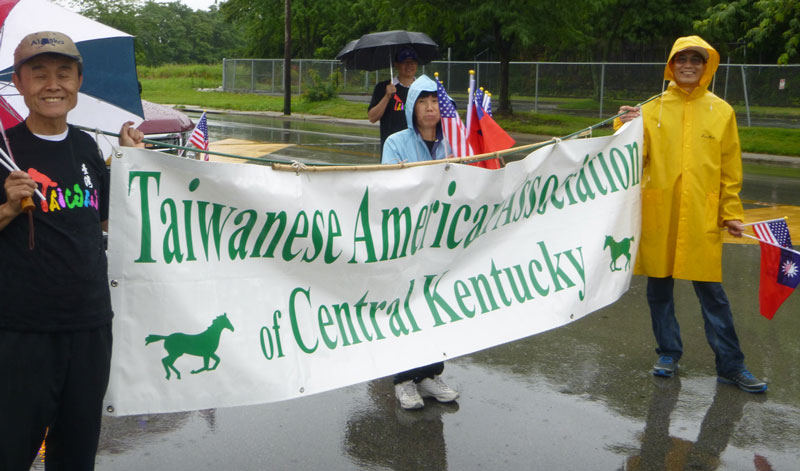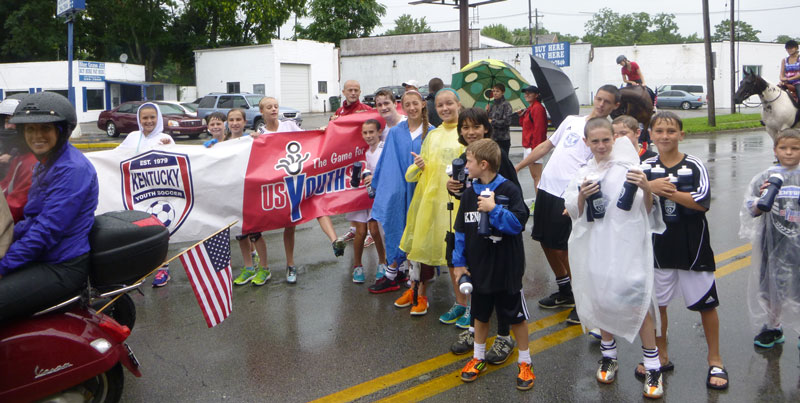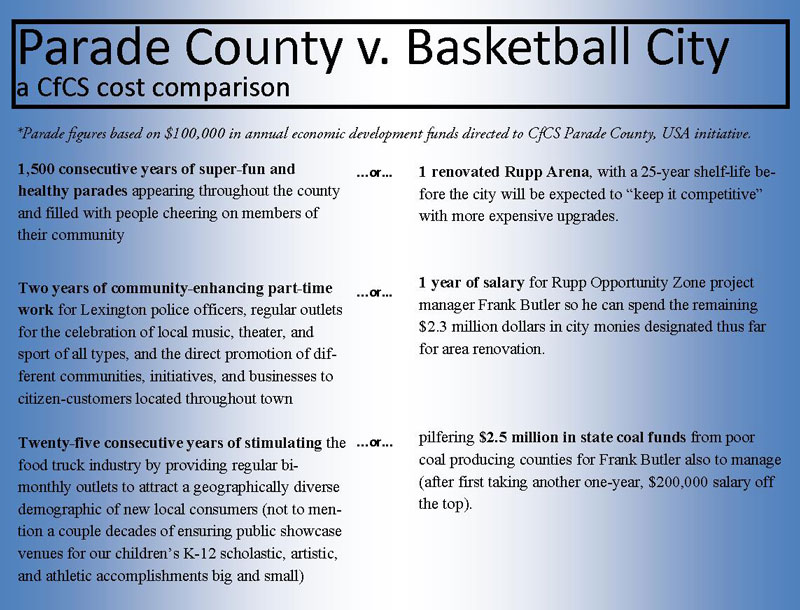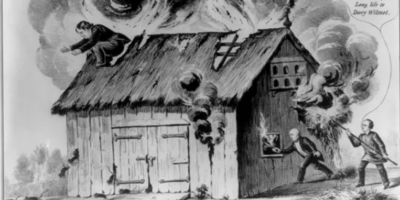Yet another Creatives for Common Sense position paper
Everybody loves a good parade. With their endless public dioramas of who-knows-what processing down the line, parades are open-access patchwork showcases of our lives—and we love them for it.

Taiwanese American Association of Central Kentucky parademembers awaittheir place in line at the Fourth of July Parade, Lexington, KY. Photo by Danny Mayer.
Big bands march. Young Republicans, old Democrats, ethnic societies, and the proletariat hike. Beauty queens, fire and police brigades, pug clubs, bikers and boxers, equestrians, the occasional unicycle, and Jerry Moody ride. And the rest of us cheer, standing firm in loose rows upon sidewalks, under building facades, along friends’ porches, evincing a rag-tag patchwork spectacle of our own, because somewhere in the procession of strange happy fellows travelling together in packs with their banners, and probably at several points, we see ourselves–or we see reflections of our neighbors, our mascots, our dreams, and ideals.
We Creatives for Common Sense (CfCS) call upon Fayette Urban County Government to build upon this common love of the public procession and to create a positive parade environment by dividing the county into eight designated Parade Eruption Zones (PEZ). Each PEZ should be criss-crossed by a series of parade routes that showcase county neighbourhoods, parks, and commercial zones appearing within it, with each zone anchored by a PEZ Station, a central public space into which various parades may choose to culminate. (In keeping with Commonwealth practice, PEZ Stations by law must lie within one hour amble of all able-bodied residents residing therein, or within two hours horse trot for individuals located far out on the rural PEZ).
To cement its commitment, we call upon city leaders to designate $100,000 in city economic development funds for the creation of 8-10 new parade routes through county PEZ, and to pass a symbolic resolution unilaterally declaring Fayette County as the “Parade Capital of the World.”
The $100,000 price tag, which should divert from city economic development funds, would pay infrastructure costs and provide monies toward a baseline commonality of talent for all parades. The roughly $8,000-12,500 cost per parade (CPP) would be put toward the following four areas.
The greatest chunk of money would fund part-time police officers for traffic and other needs, with work preference given to those police residing in a particular parade’s home PEZ. The money would also pay a small number of designated “parade performers,” who might range in type from marching bands like March Madness and Paul Lawrence Dunbar, to local bar acts like the Swells Brass Band, Tee Dee, and Sheisty Khrist; it would help fund setup and cleanup; and, finally, it would employ a single part-time person to conduct citizen input on parade routes and otherwise manage and brand all county PEZ. This person should be of good standing in the community, one whose official title shall be Grand Master of Parades, and who shall be referred to in all formal settings as Grand Master P.
A common sense business plan
Lexington is home to a good stable of community parades, but nearly all route through or near Main Street. A suburban northsider or Jessamine County parade enthusiast must always travel to the same downtown location to catch Lexington parades. So too must the Jacobson Park-er, the Meadowthorpe family of four, the Clays Mill commuter, and anyone else not residing within the increasingly unaffordable “live-work-play” downtown area. This over-reliance on the Main Street Parade (MSP), though doubtless an unintentional act, has resulted in several missed opportunities for our fair city to capitalize upon a universally common affection for parades.
Chief among these, of course, is what we Creatives miss economically. Whatever else they do for us as individuals and community members, parades are nearly 100 percent organic economic and brand stimulants. As people flood in, the events themselves operate like quick jolts of economic espresso that pump through the city body. And then, as paraders and journalists seep out and tell friends, or write coverage, or plan to return for next year’s parade, the brand image begins to take hold, burning through the media-sphere like a neat bourbon drunk slow. Think: where do you go for Mardi Gras? Which coast city holds the best Saint Patrick’s Day parade? Where do you go to see a parade on or about January 1? How about Thanksgiving Day?

Kentucky Youth Soccer parade members await their place inline at the Fourth of July Parade, Lexington, KY. Photo by Danny Mayer.
You get the point: for the host city, a good parade attracts gobs of people, money, and attention—all things we Creative Fayette Urban Countians desire.
Lexington, alas, does not have the resources, history, or iconic route-lengths to rival Tier 1 parades in New Orleans, Savannah, Anaheim, or New York City (yet). But it can compete, and it can do so by recognizing some basic principles of parade economics.
The first is that parades most directly benefit those neighbourhoods and businesses lying closest to the parade route. Mardi Gras parades in New Orleans induce residents and visitors to visit specific areas of the city (most of which lie outside Bourbon Street); Saint Patrick’s Day parades in Creative hub Savannah, Georgia, highlight those city’s downtown neighbourhoods located nearby the Savannah River, a waterbody at one point died green for the festivities; the Rose Bowl Parade most directly affects specific parts of Anaheim where the parade passes; etc. etc.
Though they may be branded as city events, it may be more apt to understand parades as a form of neighbourhood economic development. Parades provide most business owners valuable exposure to two populations converging in space-time: “local” residents who venture out to be part of the spectacle of having a parade coming into their own neighbourhood, and “outlier” visitors looking for niche items and experiences, kickass ice cream, a unique comic store, a type of public park, funnel cakes, etc. etc., that are not located in their own neighbourhoods. These experiences, and how they are mediated publicly, provide or reinforce a commercial and community identity that starts at the neighbourhood level and only then scales up to the city. As paraders “get to know” these neighbourhoods (and its people and homes and businesses) as a particular place, they begin to spend their money there—before, during, and after the festivities.
Such benefits exceed mere economics. Good parades generate healthy, creative outlets that both showcase and generate a mash-up of community leaders, schmoes, groups, performers, and the like: high school bands opening for pee-wee baseball teams, Mayors courting parade marshals, small business owners and non-profits encircled by hula hoopers, and the like. This mashing together is unpredictable, but it is always enjoyable.
For all these reasons, parade distribution is central to the CfCS plan to leverage the common affection for parades into a tool of community and economic development. Here in Lexington, our dependence on the MSP has meant that only a narrow reach of streets has enjoyed the spinoff benefits that accrue to places holding good parades. When we are always on Main, our transactions are limited to a small part of who and where and what we are. Though this may run contrary to current thought, MSP dominance in fact works to restrict access to the two essential components for good parades (and good urban areas more generally): a creative and evolving cast of walkers, and a horde of hungry parade consumers. Thus, our marketing slogan and political demand: Redistribute the Parade!
A superficial Google search reveals that the brand designation “Parade Capital of the World” has not been claimed in such an official capacity by any other American city (much less any county in America). If we have the courage and wisdom to claim it, the identity is there for the taking at a cut-rate cost of investment. Brand-wise, we FUCers could be like Dan’l Boone cutting the Wilderness Trail.
Making PEZ a reality
 To better leverage brand identities already well-entrenched in county soil, CfCS suggests that the city council declaration of Fayette County as the “Parade Capital of the World” be accompanied by new government regulations requiring that all parades occurring within Fayette County be horse-powered and, to the greatest extent possible, bourbon-fueled.
To better leverage brand identities already well-entrenched in county soil, CfCS suggests that the city council declaration of Fayette County as the “Parade Capital of the World” be accompanied by new government regulations requiring that all parades occurring within Fayette County be horse-powered and, to the greatest extent possible, bourbon-fueled.
Further, good parades have a calendar rhythm: we know when they will occur, and can spend our time scheming or pining away for their arrival. To create the conditions for this, the city, by fiat, should declare the second and fourth Saturdays of the outdoor months (April-November)* to be Parade Days, and to tie that decision into its “Parade Capital of the World” brand resolution.
Our job as Creative citizen-consumers is simply to back up that brand identity by getting to work at developing some damn good parades. Not world class, mind you. Local class.
To get your Creative minds working, here are some ideas that a spinoff CfCS ad hoc PEZ-route committee bandied about over a couple growlers of Country Boy beer. Our general methodology was to identify locally-rooted thematic and participant points of emphasis that we could celebrate as a way to create a commercial and social flavor for a particular PEZ. The idea is to have diverse groups with tangentially similar interests share the same public place, and to develop post-parade ways (markets, shows, contests, demonstrations) to keep them fertilizing each other—one never knows, after all, where the next Swells member might come from, or who will have the next set of chops like the Black Falcon.
We assumed all routes would have a rotating selection of food trucks and agricultural goods, parade and band music of all types, artisan and community group booths, funnel cakes, and enough local beer/bourbon/wine to make us all stumble and vomit.
-
A Cardinal Valley area parade might process around Oxford Circle and feature an annual “Food Truck” competition to celebrate the area’s local distinction as the Lexington birthplace of food trucks. It could also emphasize a technology thematic—technology fairs, alternative energy demonstrations, computer app contests—that could both utilize and promote the work of the neighborhood’s Jesse Higginbothom Technology Trust.
-
A Douglass Park area parade might tap into the community of artists organized by Nam Oshun who will gather there August 24 for the Hip Hop Soulfest; it also might develop a one-day basketball tournament to complement the success of the Dirt Bowl tournament, or work to include floats and activities from new nearby neighbor Bluegrass Community and Technical College.
-
A Southland parade might draw upon its local history as home to award-winning marching band Lafayette High School and invite a heavy concentration of area bands to march. Afterwards, these bands could compete for local “band cups” in divisions such as high school, college, and jazz (a flexible, poorly-named category that might include March Madness Marching Band, Tee Dee, and the Swells).
-
A Shilito Park parade might process up Cromwell and terminate in the park, where organizers could draw upon interested parties to schedule a 5-K late-morning race around the park, lacrosse and pee-wee football championships, a Bluegrass Disc Golf Association tournament, and a theater-troupe showcase hosted by BCTC theater professor and local actor/director Tim X Davis.
No doubt there are more and better ideas to be had in this fertile Land of Creatives, which means:
Hup hup, FUCers. Time to get marching on this. Budgeting for the 2014 Parade Season is fast approaching, and you’ve still got an urban Mayor and a do-nothing city council to convince, not to mention PEZ routes to plan and communities to meet.
*Parade season may be extended a month on each end according to area anthropogenic climatic warming trends.




Danny
I ain’t smoking nothing; I’m just high on the Grand Master P!
A. Nonny Mouse
Danny what have you been smoking